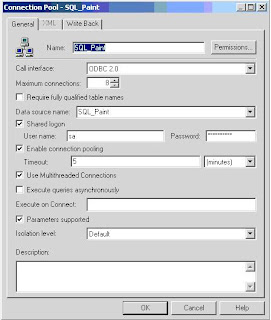The connection
pool is an object in the Physical layer, it contains information about the connection between the Oracle BI
Server and that data source.
The Physical layer in the Administration Tool contains at least one connection
pool for each database. When you create the physical layer by importing a schema
for a data source, the connection pool is created automatically.
You can configure multiple connection pools for a database.It is recommended that you create a dedicated connection pool for initialization
blocks.
It is recommended that you create a
dedicated connection pool for initialization blocks. This connection pool
should not be used for queries.
Additionally, it is recommended that
you isolate the connections pools for different types of initialization blocks.
This also makes sure that authentication and login-specific initialization
blocks do not slow down the login process. The following types should have
separate connection pools:
- All Authentication and login-specific initialization blocks.
- All initialization blocks that set session variables.
- All initialization blocks that set repository variables.
Setting Up General Properties For Connection Pools
Name : We can set any appropriate name for the connection pool based on its usage. Usage in the sense, there may be multiple connection pools for session variables, repository variables, authentication and log in purpose.
Call Interface : specify the interface through which you want the application to communicate with underlying database.To communicate with oracle databases select either odbc or native call interfaces (oci 8i/9i, oci 10g/11g).
- when a odbc is selected "Data source name:" is the name of the System DSN in odbc data source administrator.
- when a oci call interface is selected "Data source name:" is the TNS Name in the tnsnames.ora file.
3. Maximum Connections: This parameter specifies the maximum number of concurrent connections allowed.
The default is 10.
For each connection pool, you must specify the maximum number of concurrent
connections allowed. After this limit is reached, the Oracle BI Server routes
all other connection requests to another connection pool or, if no other
connection pools exist, the connection request waits until a connection becomes
available.
Increasing the allowed number of concurrent connections can potentially increase
the load on the underlying database accessed by the connection pool. Test and
consult with your DBA to make sure the data source can handle the number of
connections specified in the connection pool.
In addition to the potential load associated with the database
resources, the Oracle BI Server allocates shared memory for each connection upon
server startup. This raises the number of connections and increases Oracle BI
Server memory usage.
Make sure the “Max Connections” parameter on your connection pools are appropriately set (not too
low….not too high!). If in doubt, you can use the following formula which assumes that no more
than 4% of your users will ever be logged on and running a report at any one moment:
Max Connections = Total Users * 0.04 * Max Reports on a Dashboard
So if you have 1000 users and you have no more than 4 reports on any one dashboard, then your
“Max Connections” should be set to 160.
Require fully qualified table names : Select this check box, if the database requires it. When this option is selected, all requests sent from the connection pool use
fully qualified names to query the underlying database.
Eg: Assume that, there is a table called Emp in Physical Layer, which has imported from a default schema dbo of the database OLE.
- When we check the option Require fully qualified table names for connection pool, then the requests will contain the full qualified table name like - OLE.dbo.Emp. select ename from OLE.dbo.Emp
- When we uncheck the option Require fully qualified table names for connection pool, then the requests will contain only table name itself like - Emp. select ename from Emp
Data source name : The drop-down list shows the System DSNs configured on your system. A data source name that is configured to access the database to which you want to connect. The data source name needs to contain valid log on information for a data source. If the information is invalid, the database log on specified in the DSN will fail.
Shared logon : Select the Shared logon check box if you want all users whose queries use the connection pool to access the underlying database using the same user name and password.
If this option is selected, then all connections to the database that use the connection pool will use the user name and password specified in the connection pool, even if the user has specified a database user name and password in the DSN (or in user configuration).
If this option is not selected, connections through the connection pool use the database user ID and password specified in the DSN or in the user profile.
Enable connection pooling : Allows a single database connection to remain open for the specified time for use by future query requests. Connection pooling saves the overhead of opening and closing a new connection for every query. If you do not select this option, each query sent to the database opens a new connection.
